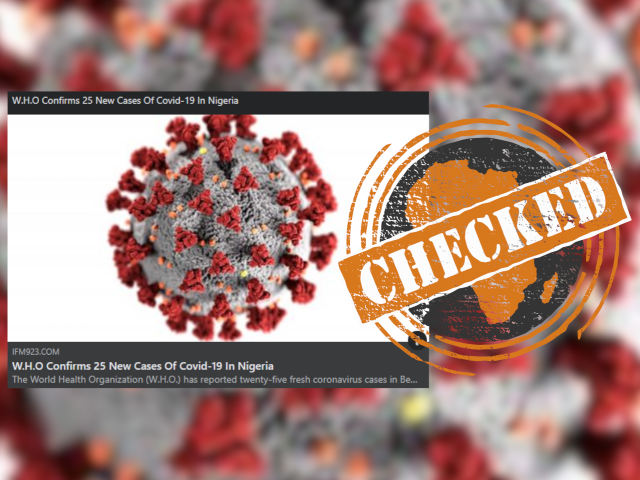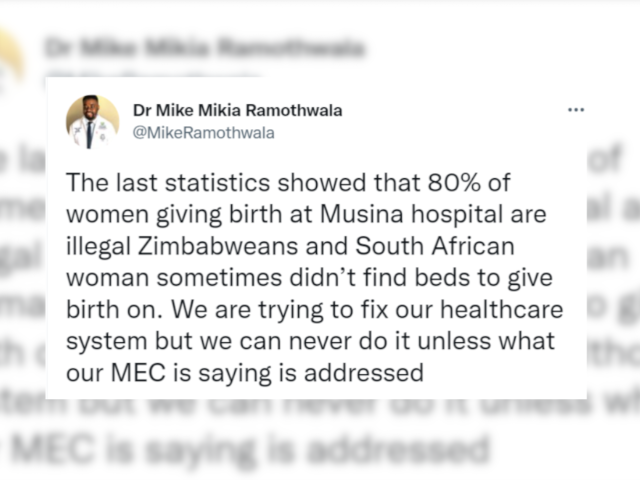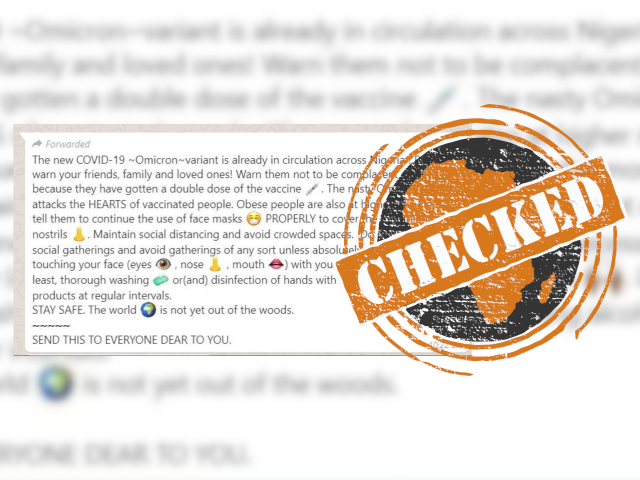This article is more than 3 years old
- While reporting on the work of local Nigerian groups in raising awareness of the blood disorder, TVC News accurately reported that Nigeria has the highest burden of the disease worldwide.
- The TV station was however off the mark with other claims about the disease in Nigeria, including the percentage of worldwide cases in the country, which is less than 35%, not 50%.
- While the disease has serious health implications for the youngest Nigerians, it is also not true that one out of every two babies born with sickle cell disease in the world is Nigerian.
Nigerians living with sickle cell disease face stigma as the illness is poorly understood, a TV station in the country reported on World Sickle Cell Day on 19 June.
Sickle cell disease is a group of disorders that affect or make sick the red blood cells in the blood stream, leading to pain and other serious health problems. It is inherited when a child receives two sickle cell genes—one from each parent.
But the disease is not a death sentence, said TVC News. The station was reporting on local groups marking international awareness days dedicated to the disease and to blood donation in Port Harcourt, the capital of Rivers state in the south of the country.
To show the national burden of sickle cell disease, the news report made three claims we looked at.
Africa Check has asked the station for its evidence for the claims and will update this report when we receive a response.
Organisations such as the country’s Sickle Cell Awareness and Health Foundation are urging the government to reduce this statistic, TVC News said. The foundation also called for affordable blood testing centres.
The “burden of disease” is a measure of how a disease or other health problem affects a population, according to the World Health Organization or WHO. This can include death or the loss of health. It is useful for making policy. (Note: For more on how it is measured read here.)
The disease burden is comparable across regions because it considers several factors such as the number of deaths, incidence, prevalence and life expectancy. Prof Tanimola Akande, of the epidemiology and community health unit of the University of Ilorin in western Nigeria, explained this to Africa Check.
The Institute for Health Metrics and Evaluation, at the University of Washington in the US, publishes data on the global burden of disease. To do this, it works with the WHO.
Its most recent data from 2017 shows Nigeria has the highest number of people with sickle cell disease and those who die from its complications.
Effect of disease in numbers
What does this look like in numbers? A measure called the Disability Adjusted Life Year, or DALY, is used. This is calculated by adding the number of years a person loses by dying prematurely from a disease, and the years lost due to living with disabilities linked to the disease.
One DALY represents the loss of a full year lived healthily and it is expressed per 100,000 of a population.
For sickle cell disorders, Nigeria had an average of 643,374 disability-adjusted life years per 100,000 people, the highest globally. For deaths it had 7,105 per 100,000, also a global high.
Incidence of sickle cell trait among Africans
The country’s population size and the incidence of the sickle cell gene and the resulting sickle cell disease play a significant role in its burden, Collins Boakye-Agyemang from the WHO’s communications team told Africa Check.
He directed us to a 2010 report that showed sickle cell disease is the most prevalent genetic disease in Africa, with between 10 and 40% of the population carrying the gene. An estimated 2% on the continent had the disease.
While national estimates were “challenging because of the lack of federal newborn screening programmes”, it was estimated that every year, at least 150,000 newborns in Nigeria had sickle-cell disease. There are about 7 million births in Nigeria annually.
Although limited data was available, Boakye-Agyeman said one newborn screening programme in Africa showed that the prevalence of the disease in newborns was 3%.
The claim that Nigeria accounts for 50% of the global sickle cell burden is incorrect, Prof Isaac Odame told Africa Check. He is the director of the Global Sickle Cell Disease Network, a community of clinicians and scientists who study the disease globally, and the Alexandra Yeo Chair in Hematology at the University of Toronto, Canada.
“No, Nigeria bears 30% of the global sickle cell burden,” said Odame.
Even if only the number of newborns with sickle cell anaemia were considered, Nigeria still wouldn’t have half the global burden.
He referred us to research on the global burden of sickle cell in children under age five which estimated that in 2010, Nigeria, India, and the Democratic Republic of the Congo represented 57% of the annual number of newborns with sickle cell anaemia.
According to the study published in 2013, these countries will account for 55% of the total by 2050, with Nigeria’s share projected to increase from 30% to 35%.
This claim is incorrect, Prof Isaac Odame from the University of Toronto, Canada, told Africa Check.
“No, one in every three babies born with sickle cell in the world is a Nigerian,” Odame said. He is also a physician in the division of haematology and oncology at the Hospital for Sick Children in Toronto, Canada.
Dr Prebo Barango, the head of the WHO’s intercountry support team for East and Southern Africa, also said the claim is off the mark.
But the country still has a high number of deaths in children from the disease, Barango said.
He identified late diagnosis and immunisation gaps, for example against pneumonia and meningitis, as some reasons for this.
“They are more prone to have adverse outcomes of not being immunised.”
Collins Boakye-Agyemang from the WHO also told Africa Check the claim is incorrect.
In Africa, deaths from complications of the disease occur mostly in children under five, adolescents and pregnant women, he said. Less than half of affected children reach their fifth birthday, with childhood mortality being between 50 and 80%.
In 2010 African countries approved a regional strategy against the disease but many are struggling to follow through on it informing the persistently high burden on the continent, Boakye-Agyemang said.





Add new comment